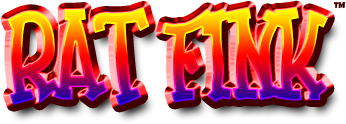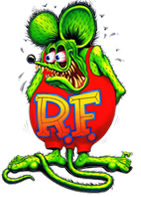Finkage At “The Pete”
Ed Roth — The Original Rat Fink Opens October 28th
Written by Drive! Magazine
Photos by Petersen Automotive Museum
Few automotive cult figures better symbolize the rebellious nature of the 1960’s hot rod movement than Ed “Big Daddy” Roth. A columnist for DRIVE! until his passing five years ago, and best known for his now iconic “Rat Fink”, widely regarded as the alter ego of Disney’s Mickey Mouse, Roth’s designs represent the dawn of a counterculture era.
Roth was the first to capitalize on a successful formula for combining cartoon characters with automobilia. His trademark designs were popularized on everything from T-shirts to wild hotrods and customs-and now they’re the centerpiece of the latest exhibition at “The Pete”. “Ed Roth-The Original Rat Fink” opens at The Petersen Automotive Museum in downtown Los Angeles on October 28th, and runs through June 3rd.
It will explore the artistic methods that Roth embraced, including drawing cartoons, pinstriping, and sculpting unique automotive creations in fiberglass. (That’s also how he used to write his columns for DRIVE!-Ed.) Like many artists, his often garish and grotesque anti-authoritarian aesthetic was not fully accepted during his lifetime. Today, his work exemplifies a period of dramatic social change and his one-of-a-kind vehicles command top dollar.
“We are thrilled to be able to present this extraordinary exhibit featuring Ed Roth’s designs as they have become major influences, not only on the automotive history of Los Angeles, but also on our nation’s pop culture, spawning a hot rod counterculture,” said Dick Messer, Director of the Petersen Automotive Museum. “Even today, his techniques continue to influence major designers in the custom car industry.”
Roth’s legend began in Southern California in the mid-’50s, when he established his reputation as a custom pinstriper and painter. He then branched out into what he called “weirdo shirts”, including famed airbrushed creations such as grotesque heads surrounded by flames- high fashion on the Southern California drag racing scene.
In 1959 he opened Roth Studios, and throughout the next decade he pushed the envelope of car customization by developing a highly recognizable iconography that he imprinted on shirts, jackets, and decals. “Rat Fink” is the most popular of the creatures fashioned by Roth.
The strikingly homely rodent, today considered the archetypal Roth monster, quickly became the darling of the Kustom Kulture revolution. Want proof of Roth’s influence? Look at RM Auctions’ Brucker Brothers collection sale at the Petersen Museum this past May, when the work of Roth (and contemporaries like Robert Williams) sold for record-breaking prices to a packed crowd of enthusiasts.
The sale included much of Roth’s most notable work, such as sketches like “Rat Fink’s Revenge”, which garnered an incredible $9,775, and “Brother Rat Fink”, which sold for a whopping $25,300-nearly three times its estimated value.
The exhibit gathers some of the most significant automobiles and designs of Ed “Big Daddy” Roth’s career including the following. The Outlaw has a custom frame fitted with a ’49 Cadillac V-8, and its body was created with fiberglass laid over a hand-carved plaster form. Featured on the cover of Car Craft in 1960, it immediately propelled Roth to star status on the custom car scene.
The Beatnik Bandit, created in 1961, incorporates a bubble canopy (made in an old pizza oven-Ed.) and joystick-style controls. In addition, inspired by the burgeoning “space race”, Roth created Rotar (the Roth Air Car). Powered by two Triumph motorcycle engines and weighing just 750 pounds, Rotar is able to hover several inches above the ground. A Roth Studios postcard of the era proclaimed, “There is a remote possibility that this will be the first car to reach the MOON.”
Roth’s Mysterion debuted in 1963. Built on a custom frame, it was a twin-engined experiment in asymmetrical design. One year later, Roth introduced the Road Agent. Named after a popular slang term for a bounty hunter or hitman, the mid-engined, bubble-topped roadster was powered by a Corvair flat-six engine.
During the heyday of his creativity, author Tom Wolfe quoted Roth as saying, “Detroit is beginning to understand that there are just a hell of a lot of these bad kids in the United States, and they are growing up. And they want a better car. They don’t want an old man’s car.”
You can peruse the museum section of our site to better get to know the life and legacy of “Big Daddy”.



